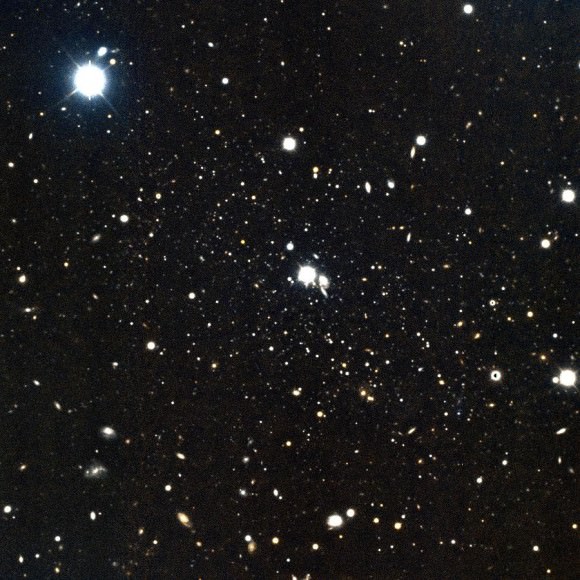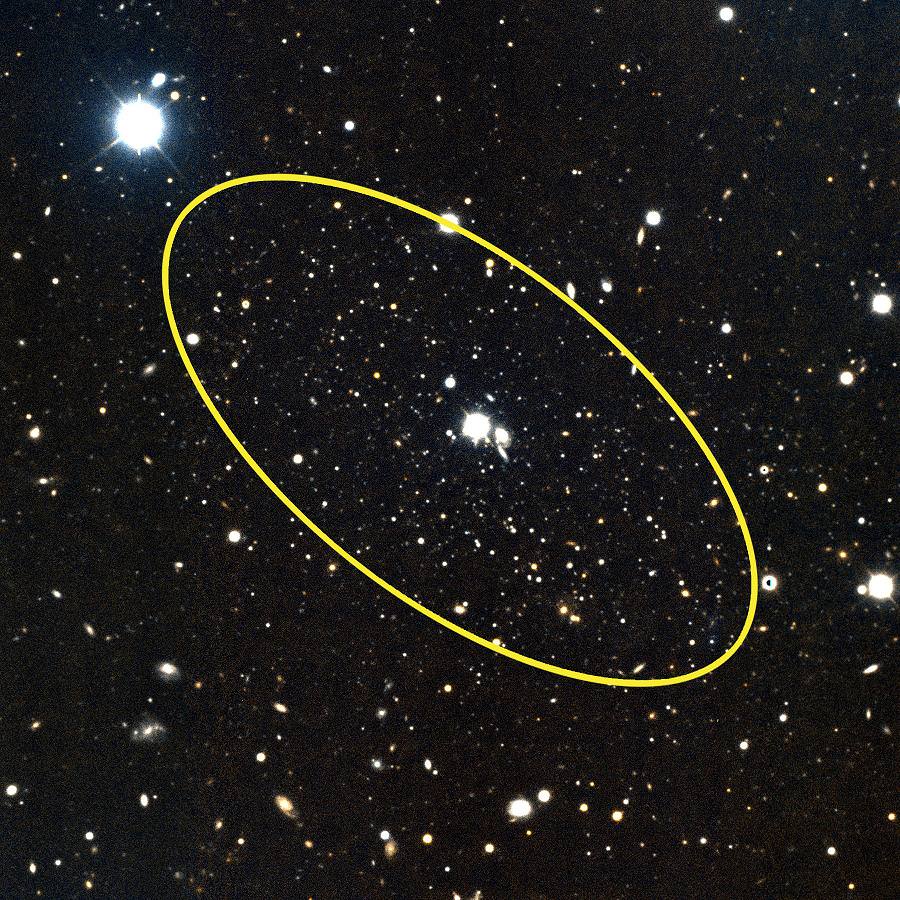[/caption]
Yep. It’s that time of year again. Time to enjoy the Andromeda Galaxy at almost every observing opportunity. But now, rather than just look at the nearest spiral to the Milky Way and sneaking a peak at satellites M32 and M110, we can think about something more when we peer M31’s way. There are two newly discovered dwarf galaxies that appear to be companions of Andromeda!
Eric Bell, an associate professor in astronomy, and Colin Slater, an astronomy Ph.D. student, found Andromeda 28 and Andromeda 29 by utilizing the Sloan Digital Sky Survey and a recently developed star counting technique. To back up their observations, the team employed data from the Gemini North Telescope in Hawaii. Located at 1.1 million and 600,000 light-years respectively, Andromeda XXVIII and Andromeda XXIX have the distinction of being the two furthest satellite galaxies ever detected away from the host – M31. Can they be spotted with amateur equipment? Not hardly. This pair comes in about 100,000 fainter than Andromeda itself and can barely be discerned with some of the world’s largest telescopes. They’re so faint, they haven’t even been classified yet.
“With presently available imaging we are unable to determine whether there is ongoing or recent star formation, which prevents us from classifying it as a dwarf spheroidal or a dwarf irregular.” explains Bell.

In their work – published in a recent edition of the edition of the Astrophysical Journal Letters – the team of Bell and Slater explains how they were searching for dwarf galaxies around Andromeda to help them understand how physical matter relates to theoretical dark matter. While we can’t see it, hear it, touch it or smell it, we know it’s there because of its gravitational influence. And when it comes to gravity, many astronomers are convinced that dark matter plays a role in organizing galaxy structure.
“These faint, dwarf, relatively nearby galaxies are a real battleground in trying to understand how dark matter acts at small scales,” Bell said. “The stakes are high.”
Right now, current consensus has all galaxies embedded in surrounding dark matter… and each “bed” of dark matter should have a galaxy. Considering the volume of the Universe, these predictions are pretty much spot on – if we take only large galaxies into account.
“But it seems to break down when we get to smaller galaxies,” Slater said. “The models predict far more dark matter halos than we observe galaxies. We don’t know if it’s because we’re not seeing all of the galaxies or because our predictions are wrong.”
“The exciting answer,” Bell said, “would be that there just aren’t that many dark matter halos.” Bell said. “This is part of the grand effort to test that paradigm.”
Right or wrong… pondering dark matter and dwarf galaxies while observing Andromeda will add a whole new dimension to your observations!
For Further Reading: Andromeda XXVIII: A Dwarf Galaxy more than 350 kpc from Andromeda and Andromeda XXIX: A New Dwarf Spheroidal Galaxy 200 kpc from Andromeda.


How do you know we can’t smell dark matter? Every once in awhile I smell something weird and cannot find the source. Could be a chunk of dark matter that just passed through the room.
Dark matter particles are likely passing through Earth, not only Earth but our bodies, right now. Dark matter particles do not interact by the electromagnetic field, for if they did they would interact by emitting electromagnetic radiation, or photons, which we can easily detect. Senory perceptions involve electromagnetic interactions between molecules. So no, you can’t smell dark matter.
LC
“So no, you can’t smell dark matter.”
I thought it smelled like a McRib: http://en.wikipedia.org/wiki/McRib
Darn it! 🙂
[Bad joke redacted.]
I’m now wondering what it was that was so bad!
Thanks for this story, Tammy. I’ve been keeping track of *many* of these new Andromeda dwarf satellite galaxies for some time now, so it’s great to see your story on the latest two denizens of our neighboring galaxy (M 31, natch). There sure is a discrepancy in the numbers of dwarf galaxies belonging to the Milky Way vs Andromeda (despite their nearly equal masses) and this is still a puzzle to those who study such dwarf galaxy systems in the Local Group (poor dwarf spiral M 33 has hardly any satellite dwarf galaxies at all, M 31 may have grabbed them in a past encounter!).
Perhaps this discrepancy has to do with the formation of the individual major galaxies and/or the formation of the Local Group itself, as has been speculated.
Meanwhile, the hunt for these dim, dark matter dominated systems in the Local Group continues.
It has been my understanding that dwarf galaxies have a lower proportion of dark matter. Yet this appears to suggest otherwise.
LC
While certainly several examples of dwarf galaxies with little dark matter have been identified, the vast majority of the dwarf galaxy populations in both the Local Group and the M 81 group have been found to be dark matter dominated.
A dwarf galaxy like Segue 1, containing ~1000 solar masses, must surely contain a much larger amount of unseen matter to resist the enormous pull of our galaxy’s enormous gravitational potential over several orbits: http://arxiv.org/PS_cache/arxiv/pdf/0909/0909.3496v1.pdf
Likewise, for the dwarf spheroidal galaxies in the Perseus Cluster to retain their shapes in light of the enormous gravitational potential of this massive cluster requires substantial amounts of dark matter:
http://www.nasa.gov/mission_pages/hubble/science/hst_img_20090312.html
http://hubblesite.org/pubinfo/pdf/2009/11/pdf.pdf
Additionally, dark matter dominated dwarf galaxies have been detected in the Andromeda Galaxy. This mounting evidence for dark matter dominated dwarfs, especially in nearby systems, is likely indicative of it’s near universal nature, barring substantial statistical and observational evidence that these observations are somehow in error.
It looks like I will need to do some back reading of phenomenology here. I am not entirely familiar with the XLD model and how it is derived. Yet I get the idea that this is a model which curve fits the rotational velocity and backs out the percentage of DM. It then appears that the ratio M_dm/M_l reaches the ~ 4.5 limit for much more modest masses. I heard a lecture by Sean Carroll on this, where these data seem to contradict what he said then around 2006.
LC
Someone forgot taste. :d But, we can know it, isn’t it like 6th sense? :d
My bed is from Dark Matter, that’s why I sleep there. 🙂
We can, atleast, now hope that Hubble’s going to observe Andromeda ! Hope…